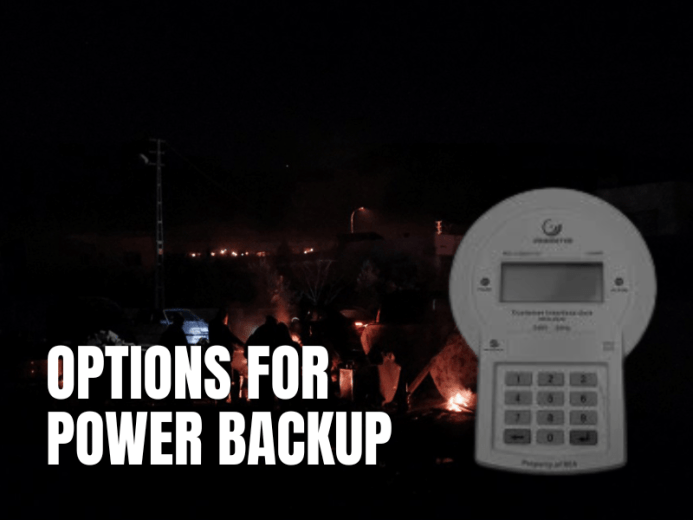Menu

A power backup, also known as a backup power system or standby power system, refers to a secondary source of electrical power used to provide electricity when the primary power supply from the utility grid (e.g., Umeme) fails or is unavailable.
Power backups are essential for ensuring uninterrupted operation of critical equipment and maintaining vital services during power outages (such as load shedding).
In Uganda, like most countries, power outages are common and generally interrupt the normal flow of life and business, often leading to a loss of money or even life. Most hospitals are equipped with standby power backup systems.
In this article, we share the different types of power backup systems to consider in Uganda.
1. Generators: Standby Generators:
Generators are the most common and widely used backup power solution among businesses in Uganda. Standby generators can automatically start up and provide power within seconds of a power outage. They are available in various sizes and fuel types, with diesel generators being more popular.
Standby generators are suitable for residential and commercial applications, providing reliable backup power during prolonged outages.
Generators serve as effective backup power solutions, but they come with some drawbacks: continuous dependency on fuel can be problematic due to fuel price fluctuations, availability, and logistical challenges, while noise and emissions contribute to environmental and health concerns, particularly in densely populated areas.
Maintenance requirements, often requiring skilled technicians and genuine spare parts, pose additional challenges. The initial cost of purchasing and installing generators, coupled with ongoing fuel expenses, may be prohibitive for some individuals and businesses.
Moreover, traditional generators tend to have lower fuel efficiency and contribute to carbon emissions, hindering efforts towards environmental sustainability.
2. UPS (Uninterrupted Power Supply)
UPS systems help to protect sensitive electronic equipment from power fluctuations and outages. They provide instant backup power by drawing energy from internal batteries, ensuring seamless operation during brief interruptions or until a standby generator kicks in. UPS systems come in different types, including offline, line-interactive, and online UPS, each offering varying levels of protection and efficiency.
UPS systems offer protection against power disruptions but have various drawbacks, including limited backup time (typically a few minutes) and limited scalability. Typically, you would need one UPS for a few computers, and you cannot use it to provide backup power for heavy appliances.
3. Rechargeable devices/appliances
In addition to larger backup power systems, rechargeable devices and appliances can serve as convenient backup solutions for smaller applications. These include rechargeable LED lights, rechargeable fans, portable power banks, and solar lanterns.
While not suitable for powering entire households or offices, they can provide emergency lighting and power for essential devices such as mobile phones and radios during short outages or until bigger backup solutions can be mobilised.
4. Grid-tied inverter-battery backups
Grid-tied inverter-battery backups offer a sustainable and reliable backup power solution for homes and businesses in Uganda. During normal operation, these systems draw power from the utility grid (Umeme) and store it in batteries through an inverter.
In the event of a power loss, the system instantly switches to battery power, providing uninterrupted electricity. Grid-tied inverter-battery backups are scalable and can be tailored to suit energy needs or various sizes.
The initial cost of acquiring grid-tied power backup systems presents a significant barrier to entry for many businesses. The investment required for purchasing batteries, inverters, and associated equipment can be substantial, deterring some businesses from adopting these systems despite their benefits.
Additionally, the technical requirements for installation and proper configuration pose challenges for many individuals and businesses. The complexity of integrating grid-tied backup systems with existing electrical infrastructure and ensuring compliance with local regulations often necessitates professional expertise, further adding to the overall cost and complexity of deployment.
5. Grid-tied Solar Power Backup System
Grid-tied solar power backup systems are another viable option for providing uninterrupted electricity in Uganda. These systems consist of solar panels, charge controllers, batteries, and inverters and are integrated with the existing electric power system, allowing households and businesses to generate and store their electricity from solar panels for use during power outages.
A grid-tied solar power backup system is the most efficient and cost-effective yet environmentally friendly form of power backup solution, with the entire investment often recoverable within 2–5 years depending on the type of batteries selected for the project.
Unlike standalone solar systems, which entirely rely on sunlight to charge the batteries and may generate less power during rainy seasons, grid-tied power backup systems can charge the backup batteries with either grid power or solar power interchangeably; it is the best of two worlds set in one. However, the initial cost of acquisition and installation is a key barrier for many.
6. Standalone solar power backup system.
A standalone solar power backup system for light equipment typically consists of essential components such as solar panels, a charge controller, a battery bank, and an inverter.
This system is specifically suitable for customers who want to keep critical equipment such as lights and CCTV camera systems running without interruption and, at the same time, save on electricity costs.
This category of power backup systems constitutes approximately 30% of the total installations we’ve completed. Hotels, furnished apartments, and residences are keen on minimising lighting electricity expenses while maintaining continuous illumination. Additionally, households seek to power TVs and phone charging ports without inflating their electricity bills. The demand for such systems is diverse and widespread, encompassing various applications beyond these examples.